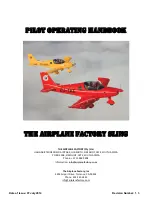
Propeller Owner’s Manual
115N
INSPECTION AND CHECK
61-00-15
Page 5-36
Rev. 24 Dec/20
CAUTION:
INSTRUCTIONS AND PROCEDURES IN THIS
SECTION MAY INVOLVE PROPELLER CRITICAL
PARTS. REFER TO THE INTRODUCTION
CHAPTER OF THIS MANUAL FOR INFORMATION
ABOUT PROPELLER CRITICAL PARTS. REFER
TO THE ILLUSTRATED PARTS LIST CHAPTER OF
THE APPLICABLE OVERHAUL MANUAL(S) FOR
THE IDENTIFICATION OF SPECIFIC PROPELLER
CRITICAL PARTS.
6. Special Inspections
A. Overspeed/Overtorque
An overspeed occurrs when the propeller RPM exceeds
the maximum RPM stated in the applicable Aircraft Type
Certificate Data Sheet. An overtorque condition occurs when
the engine load exceeds the limits established by the engine,
propeller, or airframe manufacturer. The duration of time at
overspeed/overtorque for a single event determines the
corrective action that must be taken to make sure no damage
to the propeller has occurred.
The criteria for determining the required action after an
overspeed are based on many factors. The additional
centrifugal forces that occur during overspeed are not the
only concern. Some applications have sharp increases in
vibratory stresses at RPMs above the maximum rated for the
airframe/engine/propeller combination.
(1) When a propeller installed on a reciprocating engine has
an overspeed event, refer to the Reciprocating Engine
Overspeed Limits (Figure 5-5) to determine the corrective
action to be taken.
(2) When a propeller installed on a turbine engine has an
overspeed event, refer to the Turbine Engine Overspeed
Limits (Figure 5-6) to determine the corrective action to be
taken.
(3) When a propeller installed on a turbine engine has an
overtorque event, refer to the Turbine Engine Overtorque
Limits (Figure 5-7) to determine the corrective action to be
taken.
(4) Make an entry in the propeller logbook about the
overspeed/overtorque event.














































